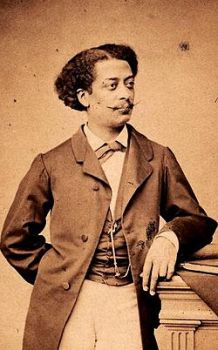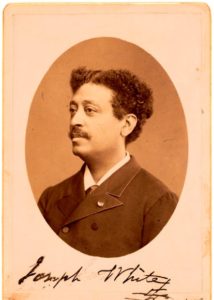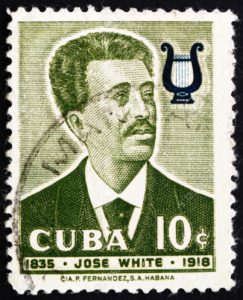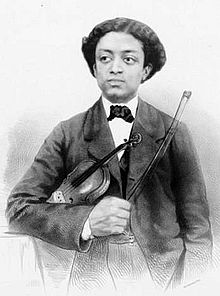José Silvestre White Lafitte was born January 17, 1836, in Matanzas, Cuba and died March 15, 1918 in Paris, France, also known as Joseph, was a famous Cuban violinist and composer.
His father Don Carlos White was Spanish and his mother was Afro-Cuban.
After receiving early musical training from his father, who was an amateur violinist, José White gave his first concert in Matanzas on 21 March 1854. He was accompanied by the visiting American pianist-composer Louis Moreau Gottschalk, “who encouraged him to pursue further violin studies in Paris and raised money for him to travel there”. José White studied at the Paris Conservatory between the years 1855 and 1871 and was highly praised by Rossini.
Matanzas saw him grow and become virtuous. Nineteen had and already dominated with great genius sixteen musical instruments including the violin, cello, viola, double bass, piano, guitar, flute, the corvetin and the eustachian tube.
White became big next to his eternal, a Stradivarius violin from 1737, called “The swan song” who always accompanied him on his many triumphs. His unsurpassed technique gave him around the world and was particularly admired in Spain, England, Venezuela, Peru, Chile, Argentina, Uruguay, Brazil and France. In the latter country won in July 1856, first prize for violin at the Paris Conservatoire, which was endorsed definitely in the European aristocracy.
Without a doubt, was the light city a place of many professional joys for the great Cuban violinist. There his music flooded the Tuileries, to emperors Napoleón III and Eugenia. And in Spain the Queen Isabel II, when he heard ringing their ropes, awarded the Gran Cruz de Carlos III and presented him with a double-breasted with brilliants.
From 1877 to 1889 White was director of the Imperial Conservatory in Rio de Janeiro, Brazil, where he served as court musician for the Emperor Pedro II.
“La Bella Cuba” composer Jose White.
His interpretive work was as fruitful as its educational work, because White was also a great teacher. Even today most novice violinists nourish your technical training with studies of the eminent musician.
Famous is his collection of six studies for violin, recognized and certified by the Committee of the studies music in the Conservatory of Paris. In these writings White theorized about the difficulties of implementation of the instrument and the necessary insight to develop the mechanism with the left hand.
This teacher was the owner of unique pieces that have become references universal. But without a doubt, one of his most beautiful works and to give him considerable fame was “The beautiful Cuban”, a true jewel of interpretation in the art of the strings.
To our luck, that great of the violin of all-time was Cuban. Rightly this musical archipelago can continue boasting lofty children like him, who carried the name of Cuba to multiple stages of the world.
White will be in memory not only because its really amazing talent, but also for making it more universal teaching of violin.
His most famous work is ‘La Bella Cubana’, a habanera. White also wrote a virtuosic violin concerto, recorded several decades ago on the Columbia label.
Agencies/Wiki/Juan B. Rodriguez/Internet Photos/ Arnoldo Varona/ TheCubanHistory.com
THE CUBAN HISTORY, HOLLYWOOD.
FOLLOW US ON TWITTER AND FACEBOOK. THECUBANHISTORY.COM
José Silvestre White Laffite nació el 17 de enero de 1836 en Matanzas, Cuba y murió el 15 de marzo de 1918 en París, Francia, también conocido como Joseph, fue un famoso violinista y compositor cubano.
Su padre don Carlos Blanco era español y su madre era afrocubana.
Después de recibir la formación musical temprana de su padre, violinista aficionado, José White dio su primer concierto en Matanzas el 21 de marzo de 1854. Fue acompañado por el pianista y compositor visitante Louis Moreau Gottschalk “, que le animó a buscar más violín Estudios en París y recaudó dinero para que viajara allí “. José White estudió en el Conservatorio de París entre los años 1855 y 1871 y fue muy elogiado por Rossini.
Matanzas lo vio crecer y llegar a ser virtuoso. Diecinueve tenían ya dominado con gran genio dieciséis instrumentos musicales incluyendo el violín, el violonchelo, la viola, el contrabajo, el piano, la guitarra, la flauta, la corvetina y la trompa de Eustaquio.
Jose White se hizo grande al lado de su eterno, un violín de Stradivarius de 1737, llamado “La canción del cisne” que siempre lo acompañó en sus muchos triunfos. Su técnica inigualable le dio en todo el mundo y fue especialmente admirado en España, Inglaterra, Venezuela, Perú, Chile, Argentina, Uruguay, Brasil y Francia. En este último país ganó en julio de 1856, primer premio de violín en el Conservatorio de París, que fue endosado definitivamente en la aristocracia europea.
Sin duda, fue la ciudad ligera un lugar de muchas alegrías profesionales para el gran violinista cubano. Allí su música inundó las Tullerías, a los emperadores Napoleón III y Eugenia. Y en España la reina Isabel II, cuando oyó sonar las cuerdas, le concedió la Gran Cruz de Carlos III y le regaló un doble pecho de brillantes.
“La Bella Cubana” creacion de José White.
De 1877 a 1889, fue director del Conservatorio Imperial de Río de Janeiro, Brasil, donde se desempeñó como músico de corte para el emperador Pedro II.
Su trabajo interpretativo fue tan fructífero como su trabajo educativo, porque White también fue un gran maestro. Incluso hoy en día la mayoría de los violinistas novatos nutren su formación técnica con estudios del eminente músico.
Famoso es su colección de seis estudios para violín, reconocidos y certificados por el Comité de los estudios musicales en el Conservatorio de París. En estos escritos White teorizó acerca de las dificultades de implementación del instrumento y la necesaria penetración para desarrollar el mecanismo con la mano izquierda.
Este maestro fue el dueño de piezas únicas que se han convertido en referencias universales. Pero sin duda, una de sus obras más bellas y para darle fama considerable fue “La Bella Cubana”, una verdadera joya de interpretación en el arte de las cuerdas.
A nuestra suerte, ese gran violín de todos los tiempos fue cubano. Con razón, este archipiélago musical puede continuar con altivos hijos como él, que llevaron el nombre de Cuba a múltiples escenarios del mundo.
Blanco estará en la memoria no sólo porque su talento realmente asombroso, sino también para hacerla enseñanza más universal del violín.
Su obra más famosa es La Bella Cubana, una habanera. White también escribió un concierto de violín virtuoso, grabado hace varias décadas en el sello Columbia.
Agencias / Wiki / Juan B. Rodriguez / Fotos de Internet / Arnoldo Varona / TheCubanHistory.com
THE CUBAN HISTORY, HOLLYWOOD.








